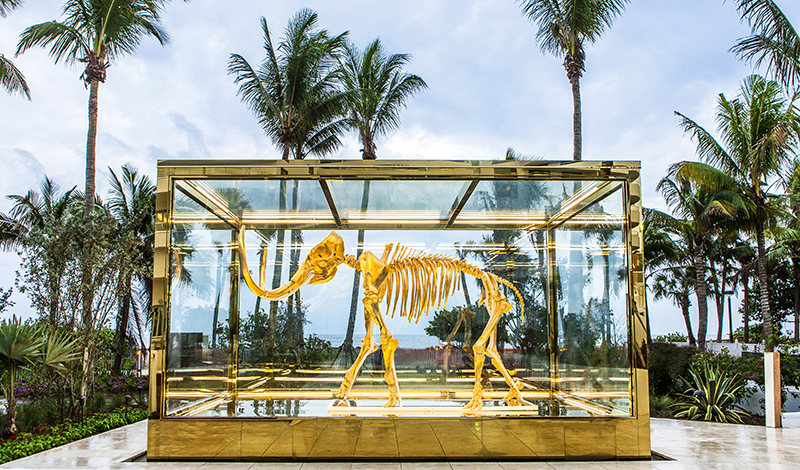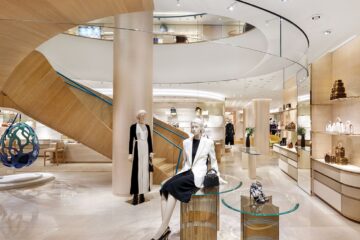Alan Faena: The Passionate Inspiration For Dynamic Urban Transformation And Creativity
Faena District Miami Beach’s arts focus has created a cultural renaissance and vibrant community connections between North and South Beach.
In today’s millisecond and megabyte world, the term “Renaissance man” may seem slightly outdated. But as we experience the game-changing of the fourth Industrial Revolution, it just might now be a descriptive more valued than ever.
Traits of a Renaissance man include quality, passion, knowledge, creativity, vision, philosophy, dreams, curiosity and perhaps that seemingly rarest of personal traits, the magic of one-on-one personal connection that comes from human interactions instead of screen time.
Just such a man is Alan Faena. He is the creative Argentine hotelier and real estate developer who has constructed cultural incubators and forward thinking urban districts in his native Buenos Aires, Argentina, as well as Miami Beach, while building his global Faena Group brand that touches architecture, design and art. His fascinating life story is revealed in his memoir released this year, Alan Faena: Alchemy & Creative Collaboration, published by Rizzoli International Publications.
Perhaps how you impact the world is somewhat preordained by when you experience it, and Faena arrived at a seminal moment of the 20th century. He was born in Buenos Aires on November 20, 1963. It was a Wednesday. Just 48 hours later, President John F. Kennedy was assassinated in Dallas, and the world changed in the blink of an eye.
By some almost mystic quirk of fate, Faena happened to be born during the opening act of the 1960s, one of the most turbulent decades of the last 100 years. A decade which brought us the cultural influence of The Beatles, the art of Andy Warhol and an exploding world of exploration, technology, design, fashion, architecture and new thinking, affecting everyone living at the time and still shaping the world we live in today. Whether we realize it or not, we are all the product of our times, and as President Kennedy himself once said of the 1960s, “The torch has been passed to a new generation.”
In recalling his family history in his new book, Faena writes: “My grandparents immigrated to Argentina from Syria in the 1910s. They were Sephardic Jews who worked in the textile industry and who lived in Damascus. The name ‘Faena’ is a Spanish word which means ‘job’ or ‘task’ — and I suppose my family has always had that touch of magic in realizing their dreams. We kept the last name and rightfully so: work has always been a core value to my family.”
Faena says his mother tells the story that even as a small boy, he was always careful about his appearance, leading to his nickname among neighbours as “the Little Prince.” His interest in clothes led him to follow the family footsteps into the textile industry, where, in keeping with the hard work ethic of the Faenas, he founded the fashion label Via Vai (which loosely translated means “coming and going, to bustle”) when he was just 19 years of age.
There, Faena’s passion for colours could erupt, which continues to this day as a signature trademark of Faena Group hotels, urban meeting places, residences and retail establishments. He launched his first fashion brand with 50 coloured shirts he funded himself, and the brand expanded to include ready-to-wear collections and a denim line, and Faena prospered as a fashion designer for more than 10 years.
While his colours were always fashion-forward, it was white that attracted him. “White does draw me: it’s powerful, holy, a clean canvas,” writes Faena. “It’s my signature and as an adult, I’ve found that white has taken on different symbolic meanings for me. White is composed of all the colours totaled together. White is clarity, intensity, innocence. White is peace. White reflects and doesn’t consume. White is the white page, the tabula rasa, the new beginning.”
As much as fashion was an interest to young Faena, so was music. Growing up, he listened to the giants of the day during the ’60s and ’70s, always entertaining his friends in his bedroom. “I’m sure every kid feels their bedroom is a special place, but my childhood bedroom really was,” writes Faena. “I was always inviting friends back home with me to entertain in my room. I took special care to make my bedroom a magical zone.”
“The Entire Faena District Is A Perfect Balance Between Art, Architecture, Nature And Technology, Conceived To Enhance People’s Lives”
Design, colours, music, communal gathering places and hospitality. Ever so slowly, the pieces of the puzzle shaping this Renaissance man begin to come into view.
“My parents raised me with a lot of love and freedom, which allowed me to develop the ability to create and explore without limits or restrictions,” Faena writes in his memoir. “I knew how to be alone — to carve my own identity in my own time and place — and early on I found that connection to art as a portal to another world.”
Faena’s interest in art would manifest itself many years later in his hometown of Buenos Aires, once he transitioned and began a career in real estate development. He partnered with Len Blavatnik, Philippe Starck and world-renowned Foster + Partners to redevelop abandoned docklands in the Puerto Madero neighbourhood of Buenos Aires, with the acclaimed Faena Hotel a central part of the urban transformation. Faena calls this his “Faena Universe,” proudly saying “it conveys the identity of the old, romantic Buenos Aires of yore, its Belle Epoque. We used the past to build the future.”
The Faena District, as it came to be known, is a $200-million development and is now estimated to be the most valuable real estate in the city.
The Faena Arts Center, a converted flour mill opened in 2011, is integral to the entire district and displays the works of local and international artists, supplying those artists with the portal to the outside world Faena himself found in his connection to art.
Faena is always quick to modestly say his collaborations with others, including friends Blavatnik and Starck, along with architect Rem Koolhaas, are a main reason for his success. “Each of my collaborations are bound by intellectual love and a deep respect for the talents of the other,” he writes. “My relationship with my collaborators has always been one of friendship first. We begin and end as friends. I think of my collaborations as a tango dance. It takes two to make an art form.”
Through this trust and mutual respect and driven by his vision and innate sense of where his artistry and creativity would succeed, Faena took his most ambitious leap in an empire full of them by expanding into Miami Beach, with construction of the Miami Beach Faena District beginning in 2013. This four-block, $1-billion, mid-beach waterfront development on Collins Avenue brought Faena’s sense of whimsy and power of experience in a captivating and intoxicating manner to one of the world’s hottest real estate markets.
“I Do Like To Think That In 100 Years People Will Be Able To See My Creations”
The anchor of the district was the neglected Saxony Hotel, an art deco masterpiece favoured decades earlier by Frank, Sammy, Dean, Marilyn, Bogart and the like. When Faena first saw it, even without interior walls and surrounded by empty lots, his curiosity was piqued. “Where people saw failure, I saw tremendous possibility,” recalls Faena. “Where people see darkness, I see the chance to bring light, and these blocks of prime real estate on a stunning stretch of beach I saw as plenty of room to create a new, experimental cultural district.”
The Saxony was completely restored as the Faena Hotel to go alongside the new Faena Miami Beach, a Forbes five-star luxury resort and the first independent hotel to achieve that rating in its first years. It was also voted as the No. 1 Miami hotel by readers of Condé Nast two years in a row.
The Faena District has completely reinvented this area of Miami Beach as a cultural incubator, showcasing the biggest names in entertainment, design, arts and community inclusiveness, including the landmark Faena Forum and featuring work ranging from arts to business and technology, as well as the Faena Theater. Recently added is the spectacular Faena Bazaar, a roller-coasteresque experiential bespoke retail experience that stimulates every nerve.
Faena’s original talent is to bring vision, creativity, pulse and vibe to urban areas previously devoid of these, by introducing his technicolour fantasies and a kaleidoscope of sensory wonders that provide magic, promise and possibilities, invigorating neighbourhoods for the greater community good.
He is new thinking and the product of his times, in exactly the right places. As The Beatles told us, “There’s nowhere you can be that isn’t where you were meant to be, it’s easy.”
“The entire Faena District is a stage choreographed in a succession of dreams,” explains Faena in his book. “It is a platform for the extraordinary, an incubator for talent, an engine that pushes the envelope forward. A perfect balance between art, architecture, nature and technology, conceived to enhance people’s lives.”
Modesty, a sense of perspective and reflection are also traits of the Renaissance man, and in his memoir Faena writes words that give an additional glimpse into a remarkable man, born into the tumult of the 1960s, then maturing to create a most fascinating and memorable career to date.
“I have not tried to conquer the world, but to ignite a part of it and share that light with others,” he writes in the “Prologue” of his book. “Everything I’ve done has started from the sparks of creativity and desire, walking from the darkness, transforming it into light. I can’t promise that what I’ve created will last forever — no person can. But I do like to think that in 100 years people will be able to see my creations. But for now, I surrender myself again to my faith, and the magic of the present.”
Faena has been a transformational influencer in the worlds of art, culture, design, architecture and urban renewal. It is safe to assume that in 100 years, when people see his creations in various corners around the globe and hear the name Alan Faena, they will want to know everything.
All Alan Faena quotes are excerpted from his memoir,
Alan Faena: Alchemy & Creative Collaboration,
published by Rizzoli International Publications, 2019.




















































































